Acer 5050, 3050 User Manual
Aspire 5050/3050 Series
User's Guide
Copyright © 2006. Acer Incorporated.
All Rights Reserved.
Aspire 5050/3050 Series User's Guide
Original Issue: 09/2006
Changes may be made periodically to the information in this publication without obligation to notify any person of such revisions or changes. Such changes will be incorporated in new editions of this manual or supplementary documents and publications. This company makes no representations or warranties, either expressed or implied, with respect to the contents hereof and specifically disclaims the implied warranties of merchantability or fitness for a particular purpose.
Record the model number, serial number, purchase date and place of purchase information in the space provided below. The serial number and model number are recorded on the label affixed to your computer. All correspondence concerning your unit should include the serial number, model number and purchase information.
No part of this publication may be reproduced, stored in a retrieval system, or transmitted, in any form or by any means, electronically, mechanically, by photocopy, recording or otherwise, without the prior written permission of Acer Incorporated.
Aspire 5050/3050 Series Notebook PC
Model number: __________________________________
Serial number: ___________________________________
Date of purchase: ________________________________
Place of purchase: ________________________________
Acer and the Acer logo are registered trademarks of Acer Incorporated. Other companies' product names or trademarks are used herein for identification purposes only and belong to their respective companies.
iii
Information for your safety and comfort
Safety instructions
Read these instructions carefully. Keep this document for future reference. Follow all warnings and instructions marked on the product.
Turning the product off before cleaning
Unplug this product from the wall outlet before cleaning. Do not use liquid cleaners or aerosol cleaners. Use a damp cloth for cleaning.
CAUTION for plug as disconnecting device
Observe the following guidelines when connecting and disconnecting power to the power supply unit:
Install the power supply unit before connecting the power cord to the AC power outlet.
Unplug the power cord before removing the power supply unit from the computerYYu/ e9 .
If the system has multiple sources of power, disconnect power from the system by unplugging all power cords from the power supplies.
CAUTION for Accessibility
Be sure that the power outlet you plug the power cord into is easily accessible and located as close to the equipment operator as possible. When you need to disconnect power to the equipment, be sure to unplug the power cord from the electrical outlet.
CAUTION for Dummy Card of PCMCIA & Express Slot
Your computer shipped with plastic dummies installed in the PCMCIA & Express slot. Dummies protect unused slots from dust, metal object, or other particles. Save the dummy for use when no PCMCIA or Express Card is installed in the slot.
Warnings
•Do not use this product near water.
•Do not place this product on an unstable cart, stand or table. If the product falls, it could be seriously damaged.
•Slots and openings are provided for ventilation to ensure reliable operation of the product and to protect it from overheating. These openings must not be blocked or covered. The openings should never be blocked by placing the product on a bed, sofa, rug or other similar surface. This product should never be placed near or over a radiator or heat register, or in a built-in installation unless proper ventilation is provided.

iv
•Never push objects of any kind into this product through cabinet slots as they may touch dangerous voltage points or short-out parts that could result in a fire or electric shock. Never spill liquid of any kind onto or into the product.
•To avoid damage of internal components and to prevent battery leakage, do not place the product on a vibrating surface.
•Never use it under sporting, exercising, or any vibrating environment which will probably cause unexpected short current or damage rotor devices, HDD, Optical drive, and even exposure risk from lithium battery pack.
Using electrical power
•This product should be operated from the type of power indicated on the marking label. If you are not sure of the type of power available, consult your dealer or local power company.
•Do not allow anything to rest on the power cord. Do not locate this product where people will walk on the cord.
•If an extension cord is used with this product, make sure that the total ampere rating of the equipment plugged into the extension cord does not exceed the extension cord ampere rating. Also, make sure that the total rating of all products plugged into the wall outlet does not exceed the fuse rating.
•Do not overload a power outlet, strip or receptacle by plugging in too many devices. The overall system load must not exceed 80% of the branch circuit rating. If power strips are used, the load should not exceed 80% of the power strip's input rating.
•This product's AC adapter is equipped with a three-wire grounded plug. The plug only fits in a grounded power outlet. Make sure the power outlet is properly grounded before inserting the AC adapter plug. Do not insert the plug into a non-grounded power outlet. Contact your electrician for details.
Warning! The grounding pin is a safety feature. Using a power outlet that is not properly grounded may result in electric shock and/or injury.
Note: The grounding pin also provides good protection from unexpected noise produced by other nearby electrical devices that may interfere with the performance of this product.
•Use the product only with the supplied power supply cord set. If you need to replace the power cord set, make sure that the new power cord meets the following requirements: detachable type, UL listed/CSA certified, type SPT-2, rated 7 A 125 V minimum, VDE approved or its equivalent, 4.6 meters (15 feet) maximum length.

v
Product servicing
Do not attempt to service this product yourself, as opening or removing covers may expose you to dangerous voltage points or other risks. Refer all servicing to qualified service personnel.
Unplug this product from the wall outlet and refer servicing to qualified service personnel when:
•the power cord or plug is damaged, cut or frayed
•liquid was spilled into the product
•the product was exposed to rain or water
•the product has been dropped or the case has been damaged
•the product exhibits a distinct change in performance, indicating a need for service
•the product does not operate normally after following the operating instructions
Note: Adjust only those controls that are covered by the operating instructions, since improper adjustment of other controls may result in damage and will often require extensive work by a qualified technician to restore the product to normal condition.
Replacing the battery pack
The notebook uses lithium batteries. Replace the battery with the same type as that which came bundled with your product. Use of another battery may present a risk of fire or explosion.
Warning! Batteries may explode if not handled properly. Do not disassemble or dispose of them in fire. Keep them away from children. Follow local regulations when disposing of used batteries.
Telephone line safety
•Disconnect all telephone lines from the equipment when not in use and/or before servicing.
•To avoid the remote risk of electric shock from lightning, do not connect the telephone line to this equipment during lightning or thunderstorms.
Warning! For safety reasons, do not use non-compliant parts when adding or changing components. Consult your reseller for purchase options.

vi
Additional safety information
Your device and its enhancements may contain small parts. Keep them out of
the reach of small children.
Operating environment
Warning! For safety reasons, turn off all wireless or radio transmitting devices when using your laptop under the following conditions. These devices may include, but are not limited to: wireless lan (WLAN), Bluetooth and/or 3G.
Remember to follow any special regulations in force in any area, and always switch off your device when its use is prohibited or when it may cause interference or danger. Use the device only in its normal operating positions. This device meets RF exposure guidelines when used normally, and it and its antenna are positioned at least 1.5 centimeters (5/8 inches) away from your body (refer to the figure below). It should not contain metal and you should position the device the above-stated distance from your body. To successfully transmit data files or messages, this device requires a good quality connection to the network. In some cases, transmission of data files or messages may be delayed until such a connection is available. Ensure that the above separation distance instructions are followed until the transmission is completed. Parts of the device are magnetic. Metallic materials may be attracted to the device, and persons with hearing aids should not hold the device to the ear with the hearing aid. Do not place credit cards or other magnetic storage media near the device, because information stored on them may be erased.
Medical devices
Operation of any radio transmitting equipment, including wireless phones, may interfere with the functionality of inadequately protected medical devices. Consult a physician or the manufacturer of the medical device to determine if they are adequately shielded from external RF energy or if you have any questions. Switch off your device in health care facilities when any regulations posted in these areas instruct you to do so. Hospitals or health care facilities may be using equipment that could be sensitive to external RF transmissions..
Pacemakers. Pacemaker manufacturers recommend that a minimum separation of 15.3 centimeters (6 inches) be maintained between wireless devices and a pacemaker to avoid potential interference with the pacemaker. These recommendations are consistent with the independent research by and recommendations of Wireless Technology Research. Persons with pacemakers should do the following:
•Always keep the device more than 15.3 centimeters (6 inches) from the pacemaker
•Not carry the device near your pacemaker when the device is switched o. If you suspect interference, switch off your device, and move it.
Hearing aids. Some digital wireless devices may interfere with some hearing aids. If interference occurs, consult your service provider.
vii
Vehicles
RF signals may affect improperly installed or inadequately shielded electronic systems in motor vehicles such as electronic fuel injection systems, electronic antiskid (antilock) braking systems, electronic speed control systems, and air bag systems. For more information, check with the manufacturer, or its representative, of your vehicle or any equipment that has been added. Only qualified personnel should service the device, or install the device in a vehicle. Faulty installation or service may be dangerous and may invalidate any warranty that may apply to the device. Check regularly that all wireless equipment in your vehicle is mounted and operating properly. Do not store or carry flammable liquids, gases, or explosive materials in the same compartment as the device, its parts, or enhancements. For vehicles equipped with an air bag, remember that air bags inflate with great force. Do not place objects, including installed or portable wireless equipment in the area over the air bag or in the air bag deployment area. If in-vehicle wireless equipment is improperly installed, and the air bag inflates, serious injury could result. Using your device while flying in aircraft is prohibited. Switch off your device before boarding an aircraft. The use of wireless teledevices in an aircraft may be dangerous to the operation of the aircraft, disrupt the wireless telephone network, and may be illegal.
Potentially explosive environments
Switch off your device when in any area with a potentially explosive atmosphere and obey all signs and instructions. Potentially explosive atmospheres include areas where you would normally be advised to turn off your vehicle engine. Sparks in such areas could cause an explosion or fire resulting in bodily injury or even death. Switch off the device at refueling points such as near gas pumps at service stations. Observe restrictions on the use of radio equipment in fuel depots, storage, and distribution areas; chemical plants; or where blasting operations are in progress. Areas with a potentially explosive atmosphere are often, but not always, clearly marked. They include below deck on boats, chemical transfer or storage facilities, vehicles using liquefied petroleum gas (such as propane or butane), and areas where the air contains chemicals or particles such as grain, dust or metal powders.
Emergency calls
Warning: You cannot make emergency calls through this device. To make an emergency call you shall dial out through your mobile phone or other telephone call system.

viii
Disposal instructions
Do not throw this electronic device into the trash when discarding.
To minimize pollution and ensure utmost protection of the global environment, please recycle. For more information on the Waste from Electrical and Electronics Equipment (WEEE) regulations, visit http://global.acer.com/about/sustainability.htm
Mercury advisory
For projectors or electronic products containing an LCD/CRT monitor or display: Lamp(s) inside this product contain mercury and must be recycled or disposed of according to local, state or federal laws. For more information, contact the Electronic Industries Alliance at www.eiae.org. For lamp-specific disposal information, check www.lamprecycle.org.

ix
ENERGY STAR is a government program (public/private partnership) that gives people the power to protect the environment in a cost effective way and without sacrificing quality or product features. Products that earn the ENERGY STAR prevent greenhouse gas emissions by meeting strict energy efficiency guidelines set by the US Environmental Protection Agency (EPA) and the US Department of Energy (DOE). In the average home, 75% of all electricity used to power home electronics is consumed while the products are turned off. ENERGY STAR qualified home electronic products in the off position use up to 50% less energy than conventional equipment. More information refers to http://www.energystar.gov and http://www.energystar.gov/powermangement.
As an ENERGY STAR partner, Acer Inc. has determined that this product meets the ENERGY STAR guidelines for energy efficiency.
This product has been shipped enabled for power management:
•Activate display’ Sleep mode within 15 minutes of user inactivity.
•Activate computer’s Sleep mode within 30 minutes of user inactivity.
•Wake the computer from Sleep mode by pushing power button.
•More power management settings can be done through Acer ePower Management.
Tips and information for comfortable use
Computer users may complain of eyestrain and headaches after prolonged use. Users are also at risk of physical injury after long hours of working in front of a computer. Long work periods, bad posture, poor work habits, stress, inadequate working conditions, personal health and other factors greatly increase the risk of physical injury.
Incorrect computer usage may lead to carpal tunnel syndrome, tendonitis, tenosynovitis or other musculoskeletal disorders. The following symptoms may appear in the hands, wrists, arms, shoulders, neck or back:
•numbness, or a burning or tingling sensation
•aching, soreness or tenderness
•pain, swelling or throbbing
•stiffness or tightness
•coldness or weakness
If you have these symptoms, or any other recurring or persistent discomfort and/or pain related to computer use, consult a physician immediately and inform your company's health and safety department.
The following section provides tips for more comfortable computer use.
x
Finding your comfort zone
Find your comfort zone by adjusting the viewing angle of the monitor, using a footrest, or raising your sitting height to achieve maximum comfort. Observe the following tips:
•refrain from staying too long in one fixed posture
•avoid slouching forward and/or leaning backward
•stand up and walk around regularly to remove the strain on your leg muscles
•take short rests to relax your neck and shoulders
•avoid tensing your muscles or shrugging your shoulders
•install the external display, keyboard and mouse properly and within comfortable reach
•if you view your monitor more than your documents, place the display at the center of your desk to minimize neck strain
Taking care of your vision
Long viewing hours, wearing incorrect glasses or contact lenses, glare, excessive room lighting, poorly focused screens, very small typefaces and low-contrast displays could stress your eyes. The following sections provide suggestions on how to reduce eyestrain.
Eyes
•Rest your eyes frequently.
•Give your eyes regular breaks by looking away from the monitor and focusing on a distant point.
•Blink frequently to keep your eyes from drying out.
Display
•Keep your display clean.
•Keep your head at a higher level than the top edge of the display so your eyes point downward when looking at the middle of the display.
•Adjust the display brightness and/or contrast to a comfortable level for enhanced text readability and graphics clarity.
•Eliminate glare and reflections by:
•placing your display in such a way that the side faces the window or any light source
•minimizing room light by using drapes, shades or blinds
•using a task light
•changing the display's viewing angle
•using a glare-reduction filter
•using a display visor, such as a piece of cardboard extended from the display's top front edge
•Avoid adjusting your display to an awkward viewing angle.
•Avoid looking at bright light sources, such as open windows, for extended periods of time.

xi
Developing good work habits
Develop the following work habits to make your computer use more relaxing and productive:
•Take short breaks regularly and often.
•Perform some stretching exercises.
•Breathe fresh air as often as possible.
•Exercise regularly and maintain a healthy body.
Warning! We do not recommend using the computer on a couch or bed. If this is unavoidable, work for only short periods, take breaks regularly, and do some stretching exercises.
Note: For more information, please refer to "Regulations and safety notices" on page 90 in the AcerSystem User's Guide.

xii
First things first
We would like to thank you for making an Acer notebook your choice for meeting your mobile computing needs.
Your guides
To help you use your Acer notebook, we have designed a set of guides:
First off, the Just for Starters... poster helps you get started with setting up your computer.
The printed User's Guide introduces you to the basic features and functions of your new computer. For more on how your computer can help you to be more productive, please refer to the AcerSystem User's Guide. This guide contains detailed information on such subjects as system utilities, data recovery, expansion options and troubleshooting. In addition it contains warranty information and the general regulations and safety notices for your notebook. It is available in Portable Document Format (PDF) and comes preloaded on your notebook. Follow these steps to access it:
1Click on Start, All Programs, AcerSystem.
2Click on AcerSystem User's Guide.
Note: Viewing the file requires Adobe Reader. If Adobe Reader is not installed on your computer, clicking on AcerSystem User's Guide will run the Adobe Reader setup program first. Follow the instructions on the screen to complete the installation. For instructions on how to use Adobe Reader, access the Help and Support menu.
Basic care and tips for using your computer
Turning your computer on and off
To turn on the computer, simply press and release the power button below the LCD screen beside the easy-launch buttons. See "Front view" on page 13 for the location of the power button.

xiii
To turn the power off, do any of the following:
•Use the Windows shutdown command
Click on Start, Turn Off Computer, then click on Turn Off.
•Use the power button
You can also shut down the computer by closing the display cover, or by pressing the sleep hotkey <Fn> + <F4>.
Note: If you cannot power off the computer normally, press and hold the power button for more than four seconds to shut down the computer. If you turn off the computer and want to turn it on again, wait at least two seconds before powering up.
Taking care of your computer
Your computer will serve you well if you take care of it.
•Do not expose the computer to direct sunlight. Do not place it near sources of heat, such as a radiator.
•Do not expose the computer to temperatures below 0 ºC (32 ºF) or above 50 ºC (122 ºF).
•Do not subject the computer to magnetic fields.
•Do not expose the computer to rain or moisture.
•Do not spill water or any liquid on the computer.
•Do not subject the computer to heavy shock or vibration.
•Do not expose the computer to dust or dirt.
•Never place objects on top of the computer.
•Do not slam the computer display when you close it.
•Never place the computer on uneven surfaces.
Taking care of your AC adapter
Here are some ways to take care of your AC adapter:
•Do not connect the adapter to any other device.
•Do not step on the power cord or place heavy objects on top of it. Carefully route the power cord and any cables away from foot traffic.
•When unplugging the power cord, do not pull on the cord itself but pull on the plug.
•The total ampere ratings of the equipment plugged in should not exceed the ampere rating of the cord if you are using an extension cord. Also, the total current rating of all equipment plugged into a single wall outlet should not exceed the fuse rating.
xiv
Taking care of your battery pack
Here are some ways to take care of your battery pack:
•Use only batteries of the same kind as replacements. Turn the power off before removing or replacing batteries.
•Do not tamper with batteries. Keep them away from children.
•Dispose of used batteries according to local regulations. Recycle if possible.
Cleaning and servicing
When cleaning the computer, follow these steps:
1Turn off the computer and remove the battery pack.
2Disconnect the AC adapter.
3Use a soft, moist cloth. Do not use liquid or aerosol cleaners.
If either of the following occurs:
•the computer has been dropped or the body has been damaged;
•the computer does not operate normally
please refer to "Frequently asked questions" on page 41.
Information for your safety and comfort
Safety instructions Additional safety information Operating environment Medical devices
Vehicles
Potentially explosive environments Emergency calls
Disposal instructions
Tips and information for comfortable use
First things first
Your guides
Basic care and tips for using your computer Turning your computer on and off Taking care of your computer
Taking care of your AC adapter Taking care of your battery pack Cleaning and servicing
Acer Empowering Technology
Empowering Technology password Acer ePower Management
Acer ePresentation Management
Acer eDataSecurity Management (for selected models)
Acer eLock Management Acer eRecovery Management Acer eSettings Management
Acer ePerformance Management
Your Acer notebook tour
Front view Closed front view Left view
Right view Rear view Base view
Specifications Indicators Easy-launch buttons Touchpad
Touchpad basics
Using the keyboard
iii iii vi vi vi vii vii vii viii
ix xii
xii xii xii xiii xiii xiv xiv
1
1
2
5
6
7
9
11
12
13
13
14
15
16
17
18
19
23
24
25
25
27
Contents
Lock keys and embedded numeric keypad |
27 |
Windows keys |
28 |
Hotkeys |
28 |
Special keys |
30 |
Ejecting the optical (CD or DVD) drive tray |
31 |
Using a computer security lock |
31 |
Audio |
32 |
Adjusting the volume |
32 |
Acer OrbiCam |
|
(for selected models) |
33 |
Launching the Acer OrbiCam |
34 |
Changing the Acer OrbiCam settings |
34 |
Capturing photos/videos |
37 |
Using the Acer OrbiCam as webcam |
37 |
Using the system utilities |
38 |
Acer GridVista (dual-display compatible) |
38 |
Launch Manager |
39 |
Norton AntiVirus |
40 |
Frequently asked questions |
41 |
Requesting service |
44 |
International Travelers Warranty (ITW) |
44 |
Before you call |
44 |
Acer Arcade |
45 |
48-button remote control |
46 |
Remote functions |
47 |
Finding and playing content |
48 |
Settings |
48 |
Arcade controls |
49 |
Navigation controls |
49 |
Player controls |
49 |
Virtual keyboard |
50 |
Background mode |
50 |
Cinema |
51 |
Settings |
51 |
Album |
52 |
Editing Pictures |
52 |
Slide Show settings |
52 |
Video |
53 |
Playing a video file |
53 |
Capturing video (TV models only) |
53 |
Snapshot |
53 |
Editing video |
54 |
Music |
54 |
TV (for selected models) |
55 |
Time-shift functionality |
55 |
Recorded TV |
56 |
Scheduling recordings |
56 |
Program guide |
56 |
Find program |
56 |
TV settings |
56 |
Using TeleText functions |
57 |
Make DVDs |
58 |
Authoring CD/DVDs |
58 |
Taking your notebook PC with you |
59 |
Disconnecting from the desktop |
59 |
Moving around |
59 |
Preparing the computer |
59 |
What to bring to meetings |
60 |
Taking the computer home |
60 |
Preparing the computer |
60 |
What to take with you |
60 |
Special considerations |
61 |
Setting up a home office |
61 |
Traveling with the computer |
61 |
Preparing the computer |
61 |
What to take with you |
61 |
Special considerations |
62 |
Traveling internationally with the computer |
62 |
Preparing the computer |
62 |
What to bring with you |
62 |
Special considerations |
62 |
Securing your computer |
63 |
Using a computer security lock |
63 |
Using passwords |
63 |
Entering passwords |
64 |
Setting passwords |
64 |
Expanding through options |
65 |
Connectivity options |
65 |
Fax/data modem |
65 |
Built-in network feature |
66 |
Universal Serial Bus (USB) |
66 |
PC Card slot |
67 |
Installing memory |
68 |
BIOS utility |
68 |
Boot sequence |
68 |
Password |
69 |
Using software |
70 |
Playing DVD movies |
70 |
Acer eRecovery Management |
70 |
Create backup |
72 |
Restore from backup |
72 |
Create factory default image CD |
73 |
Re-install bundled software without CD |
73 |
Change password |
74 |
Troubleshooting |
75 |
Troubleshooting tips |
75 |
Error messages |
75 |
Regulations and safety notices |
77 |
FCC notice |
77 |
Modem notices |
78 |
Laser compliance statement |
81 |
LCD pixel statement |
81 |
Macrovision copyright protection notice |
81 |
Radio device regulatory notice |
82 |
General |
82 |
European Union (EU) |
82 |
The FCC RF safety requirement |
84 |
Canada — Low-power license-exempt radio |
|
communication devices (RSS-210) |
85 |
Federal Communications Comission |
|
Declaration of Conformity |
86 |
|
87 |
LCD panel ergonomic specifications |
88 |
Index |
89 |

1
Acer Empowering Technology
Acer's innovative Empowering Technology toolbar makes it easy for you to access frequently used functions and manage your new Acer computer. Displayed by default in the upper-right corner of your screen, it features the following handy utilities:
•Acer ePower Management extends battery power via versatile usage profiles.
•Acer ePresentation Management connects to a projector and adjusts display settings conveniently.
•Acer eDataSecurity Management (for selected models) protects data with passwords and advanced encryption algorithms.
•Acer eLock Management (for selected models) limits access to external storage media and interfaces.
•Acer eRecovery Management backs up and recovers data flexibly, reliably and completely.
•Acer eSettings Management accesses system information and adjusts settings easily
•Acer ePerformance Management improves system performance by optimizing disk space, memory and registry settings..
For more information, right click on the Empowering Technology toolbar, then select the Help or Tutorial function.
Empowering Technology password
Before using Acer eLock Management and Acer eRecovery Management, you must initialize the Empowering Technology password. Right-click on the Empowering Technology toolbar and select "Password Setup" to do so. If you do not initialize the Empowering Technology password, you will be prompted to do so when running Acer eLock Management or Acer eRecovery Management for the first time.
Technology Empowering

Empowering Technology
2
Acer ePower Management 
Acer ePower Management features a straightforward user interface. To launch it, select Acer ePower Management from the Empowering Technology interface.
AC mode (Adapter mode)
The default setting is "Maximum Performance." You can adjust CPU speed, LCD brightness and other settings, or click on buttons to turn the following functions on/off: Wireless LAN, Bluetooth, CardBus, FireWire(1394), Wired LAN and Optical Device if supported.
DC mode (Battery mode)
There are four pre-defined profiles — Entertainment, Presentation, Word Processing, and Battery Life. You can also define up to three of your own.
To create a new power profile:
1Change power settings as desired.
2Click "Save as ..." to save to a new power profile.
3Name the newly created profile.
4Select whether this profile is for Adapter or Battery mode, then click OK.
5The new profile will appear in the profile list.
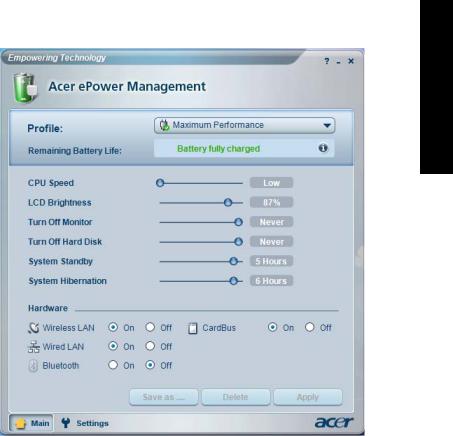
3
Battery status
For real-time battery life estimates based on current usage, refer to the panel in the upper half of the window.
For additional options, click "Settings" to:
•Set alarms.
•Re-load factory defaults.
•Select what actions to be taken when the cover is closed or the power button is pressed.
•Set passwords for accessing the system after Hibernation or Standby.
•View information about Acer ePower Management.
Technology Empowering
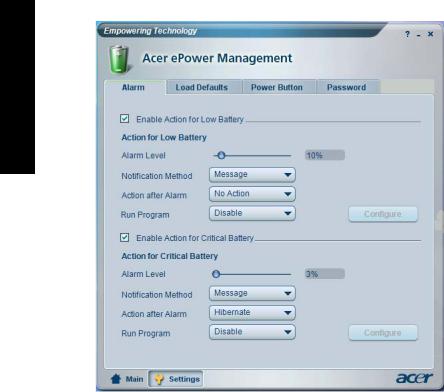
4
Empowering Technology
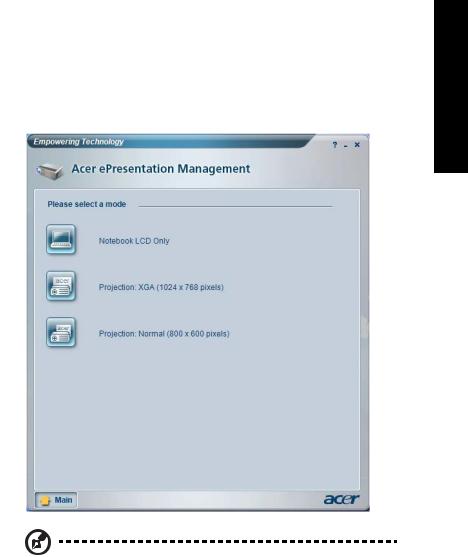
5
Acer ePresentation Management 
Acer ePresentation Management lets you project your computer's display to an external device or projector using the hot key: Fn + F5. If auto-detection hardware is implemented in the system and the external display supports it, your system display will be automatically switched out when an external display is connected to the system. For projectors and external devices that are not auto-detected, launch Acer ePresentation Management to choose an appropriate display setting.
Technology Empowering
If the restored resolution is not correct after disconnecting a projector, or you need to use an external resolution that is not supported by Acer ePresentation Management, adjust your display settings using Display Properties or the utility provided by the graphics vendor.
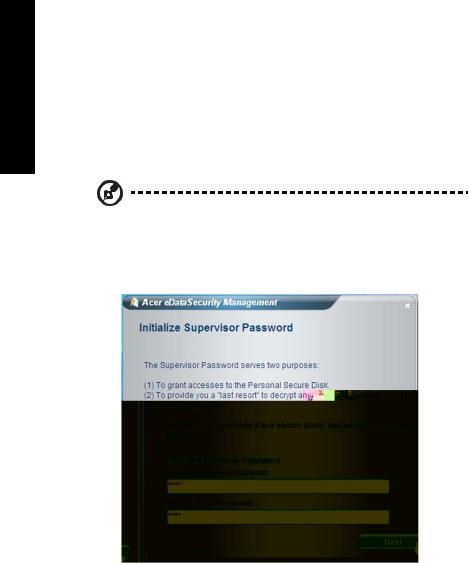
Empowering Technology
6
Acer eDataSecurity Management 
(for selected models)
Acer eDataSecurity Management is a handy file encryption utility that protects your files from being accessed by unauthorized persons. It is conveniently integrated with Windows Explorer as a shell extension for quick and easy data encryption/decryption and also supports on-the-fly file encryption for MSN Messenger and Microsoft Outlook.
The Acer eDataSecurity Management setup wizard will prompt you for a supervisor password and default encryption. This encryption will be used to encrypt files by default, or you can choose to enter your own file-specific password when encrypting a file.
Note: The password used to encrypt a file is the unique key that the system needs to decrypt it. If you lose the password, the supervisor password is the only other key capable of decrypting the file. If you lose both passwords, there will be no way to decrypt your encrypted file! Be sure to safeguard all related passwords!
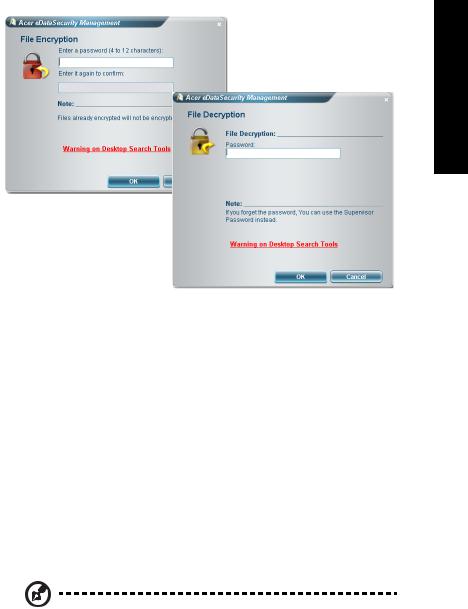
7
Technology Empowering
Acer eLock Management
Acer eLock Management is a security utility that allows you to lock your removable data, optical and floppy drives to ensure that data can't be stolen while your notebook is unattended.
•Removable data devices — includes USB disk drives, USB pen drives, USB flash drives, USB MP3 drives, USB memory card readers, IEEE 1394 disk drives and any other removable disk drives that can be mounted as a file system when plugged into the system.
•Optical drive devices — includes any kind of CD-ROM or DVD-ROM drives.
•Floppy disk drives — 3.5-inch disks only.
To activate Acer eLock Management, a password must be set first. Once set, you can apply locks to any of the devices types. Lock(s) will immediately
be set without any reboot necessary, and will remain locked after rebooting, until unlocked.
Note: If you lose your password, there is no method to reset it except by reformatting your notebook or taking your notebook
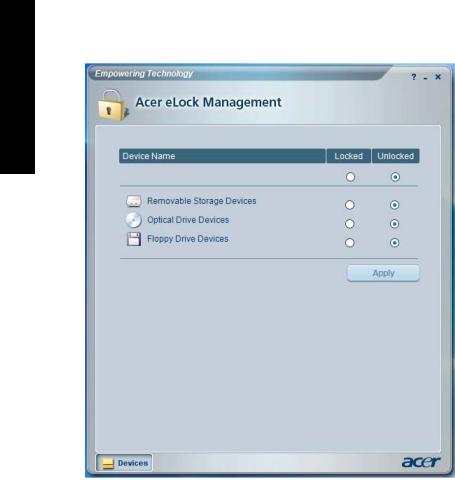
Empowering Technology
8
to an Acer Customer Service Center. Be sure to remember or write down your password.

9
Acer eRecovery Management 
Acer eRecovery Management is a powerful utility that does away with the need for recovery disks provided by the manufacturer. The Acer eRecovery Management utility occupies space in a hidden partition on your system's hard drive. By default, user-created backups are stored on the D:\ drive.
Acer eRecovery Management provides you with:
•Password protection.
•Recovery of applications and drivers.
•Image/data backup:
•Back up to HDD (set recovery point).
•Back up to CD/DVD.
•Image/data recovery tools:
•Recover from a hidden partition (factory defaults).
•Recover from the HDD (most recent user-defined recovery point).
•Recover from CD/DVD.
Technology Empowering
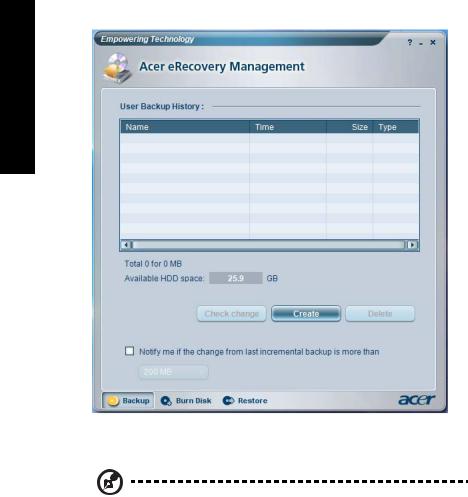
10
Empowering Technology
For more information, please refer to "Acer eRecovery Management" on page 70 in the AcerSystem User's Guide.
Note: If your computer did not come with a Recovery CD or System CD, please use Acer eRecovery Management's "System backup to optical disk" feature to burn a backup image to CD or DVD. To ensure the best results when recovering your system using a CD or Acer eRecovery Management, detach all peripherals (except the external Acer ODD, if your computer has one), including your Acer ezDock.
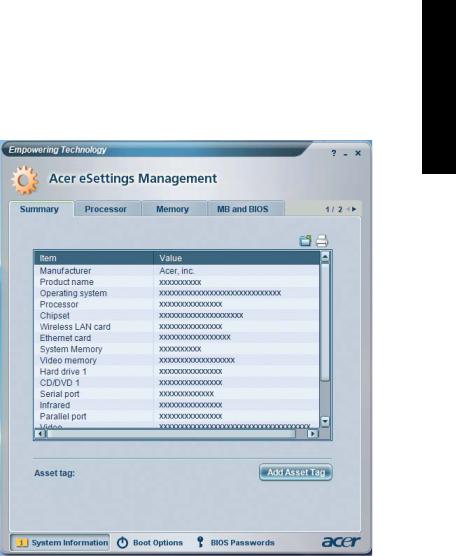
11
Acer eSettings Management 
Acer eSettings Management allows you to inspect hardware specifications, change BIOS passwords or other Windows settings, and to monitor the system health status.
Acer eSettings Management also:
•Provides a simple graphical user interface for navigation.
•Displays general system status and advanced monitoring for power users on Acer computer.
Technology Empowering
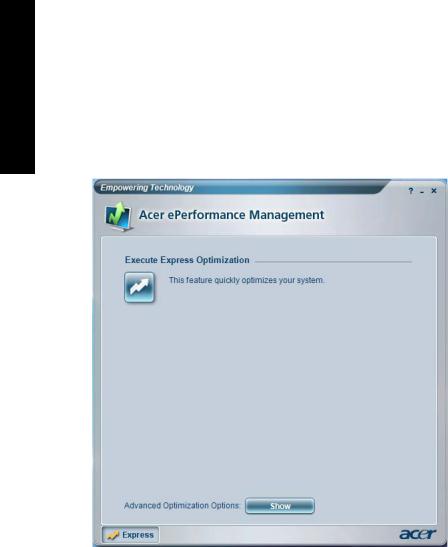
Empowering Technology
12
Acer ePerformance Management 
Acer ePerformance Management is a system optimization tool that boosts the performance of your Acer computer. It provides an express optimization method to release unused memory and disk space quickly. The user can also enable advanced options for full control over the following options:
•Memory optimization — releases unused memory and check usage.
•Disk optimization — removes unneeded items and files.
•Speed optimization — improves the usability and performance of your Windows XP system.
